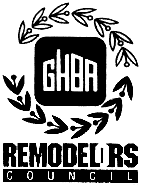Critical Part of Remodeling Project
DOUGLAS
E. SMITH
Smith Custom Builders
The
building envelope (the products that surround the structure/frame of the
home) keeps out rain, ground water, wind, noise, heat in summer, cold
in winter and protects it from damage.
The climate we live in determines the products used in the
building envelope design.
The home must be designed with products that stop bulk water
intrusion into the home, but allow the house to breathe. This is accomplished
by the use of weather barriers like housewrap, plastic, peel and stick
tape, spray foam, metal flashings and sheathing.
With the high moisture content in our air, we must use products
that have high "permeability" (the ability to holdout bulk water,
but allow moisture vapor to pass).
Moisture travels from hot hu- mid space (outdoors) to cooler
dry space (indoors). Your home should allow moisture vapor to move through
its envelope by way of diffusion" (movement of moisture in the vapor
state as a result of 81 vapor pressure difference or a temperature difference).
Once moisture vapor has passed through the outside envelope,
it must not be slowed or stopped before it enters the conditioned space
-this means "no" double vapor barrier, like paper on the inside
of the insulation, plastic under the Sheetrock and/or vinyl wall coverings.

If
you have ever seen windows sweat on the inside where water runs down onto
the window sill, this is a perfect example of the same problem that happens
to Sheetrock when insulation is compressed or has flattened out over the
years.
This
allows the hot moist air from outside to come in direct contact with the
cool dry Sheetrock
inside, causing mold to grow.
So when you hear that builders design homes much tighter
than we used to, this really means we seal the homes with better products
that breathe but hold out bulk water. This is what is meant by the term
"tight homes".
The strength of the overall structure also is a factor in
the home's envelope. Plywood sheathing installed on the outside of the
complete frame increases the racking strength by a factor of eight times.
(Racking refers to wind-driven movement of a struc- ture.) This means
windows, doors, roofs and imy component used in the structure will be
less likely to have potential Ieaks or problems in the future.
Determined by the "zone" you live in, resistance
to wind loads is met by different applications of plywood, sheer walls,
hurricane steel, steel members and hold- down anchors. The structural
engineer uses this information in his/her calculations.
In remodeling, when structural changes are to be made, it
is man- datory to have the structural engineer review existing conditions
to best meet the needs of that structure.
Remember, different builders use different products but the
end result should be the same protecting your home's structure from the
elements while allowing it to breathe.
Applications
such as these cause the moisture vapor to become trapped inside the wall
cavity. With no way to dry out. The moisture vapor must flow through the
Sheetrock evenly, allowing it to dry out with the air-conditioning
system.
This brings up the problem of air leaks through the
home's envelope via holes from pipes, wires, plate line (bottom of walls),
around windows, dryer vents or any other penetrations through the home's
envelope.
Air leakage in any wall can allow as much as 15 times
more moisture to enter through that small penetration than through a complete
wall. This moisture can condense on any cold surface, Sheetrock, wood
and tile, creating moisture-related problems (mold).
Problems also are created by the improper installation
of insulation. Insulation must never be compressed smaller or thinner
than its factory design.
and Remodel Design of the Year under $250,000.
The Greater Houston Builders Association Remodelors Council provided this article.
For more information, contact the council at remodelers@ghba.org or, write/visit Greater Houston Builders Association c/o Remodelors. Council 9511 W. Sam Houston Parkway N., Houston, TX 77064.